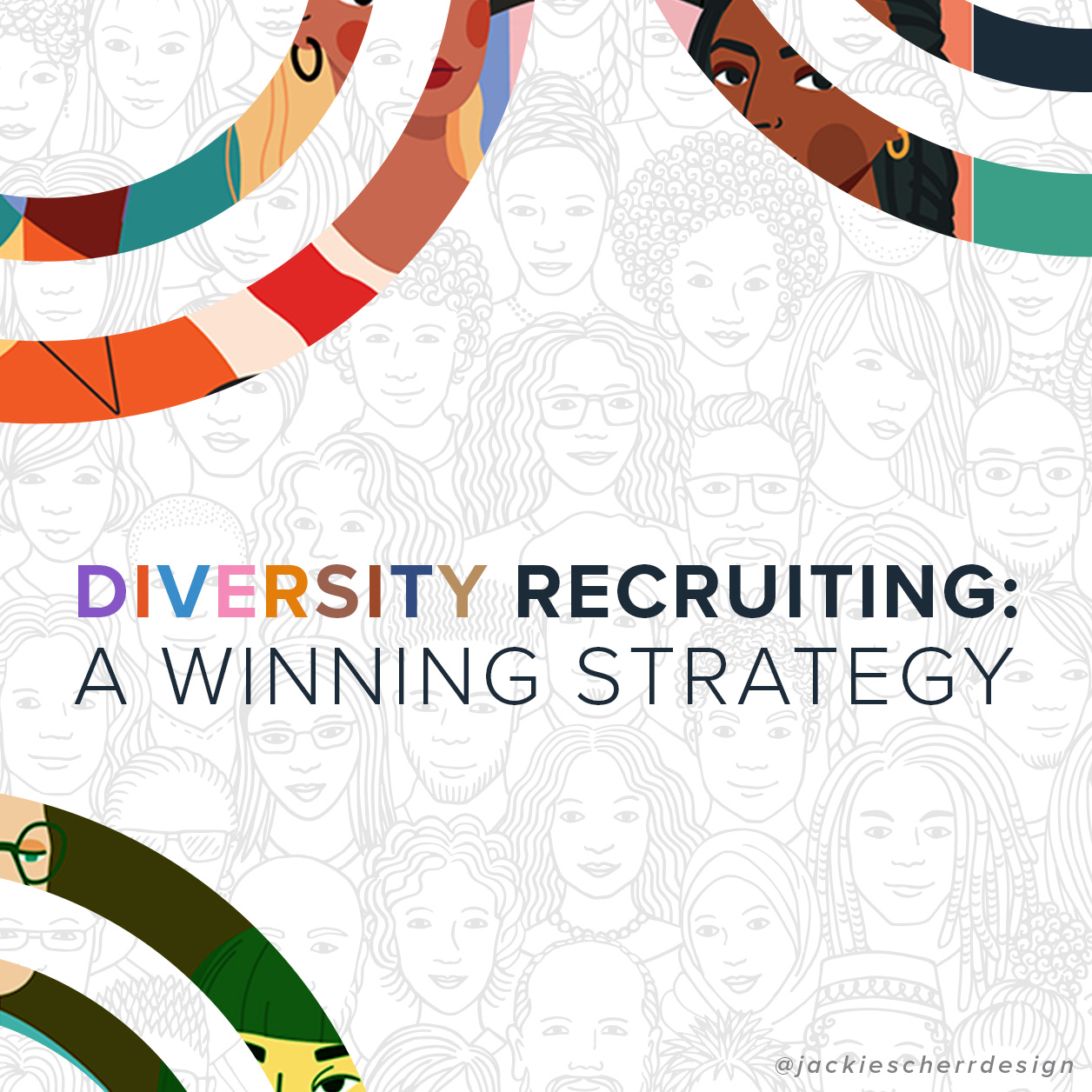The rationale for diversity, equity, and inclusion in recruiting is stronger than ever. Research has revealed, again and again, that organizations with diverse workforces perform better financially. As our ideas about work continue to evolve at a rapid clip, companies that are not fashioning more equitable workplaces are being left behind.
Workplace diversity is the idea that your company should reflect the makeup of the society around you — including race, ethnicity, gender, sexual orientation, religion, age, physical ability, and more. Diversity recruiting is the dedicated practice of searching for and hiring candidates using a merit-based process. It is structured to give all applicants an equal opportunity.
Why is a Diversity Recruiting Strategy Important?
Expanding your team’s range of cultural awareness, skills, and experience will positively benefit your business performance and productivity. Organizations that include people of different races, ethnicities, genders, cultural backgrounds, sexual orientations produce significantly more innovative, creative, and effective results. According to research conducted by Oracle, businesses with the most diversity outperform those with little diversity by 36%. And CEOs concur, with 85% saying that having a diverse workforce has improved their bottom lines.
As issues around lack of diversity become more evident, job-seekers are doing more research into a company’s culture, diversity, and inclusion, paying particular attention to the makeup of a prospective employer’s existing workforce and leadership team. More than three quarters of job-seekers say diversity is essential when considering companies and job offers. If people feel unwelcome in this tight talent market, they will not opt to work for you.
“Diversity in the workplace is extremely important to candidates, as they want to work for a company that is made up of people with different ideas, backgrounds and life experiences,” says Shannon Robinson, a senior recruiter for Creative Circle. “When candidates see a variety of different types of people in various departments, as well as in middle management and senior management, then they know they’ll have a fair shot at those opportunities as well.”
But diversity does not just *happen* — organizations need to actively pursue, recruit, and engage candidates from distinct backgrounds to foster a more inclusive workforce, which is why having a smart diversity recruiting strategy matters. The first step to building a more diverse team? Craft a recruitment process that generates a robust and varied candidate pipeline. Here are some tips that can help.
Defining Your Diversity Recruitment Goals
The first step in crafting a smart diversity recruiting plan is to lay out what you want to achieve. Every organization needs to assess the right diversity and inclusion strategy based on culture, industry, regional nuances, and more — there is no one-size-fits-all approach. Some key questions to ask include:
- What are our DEI goals?
- How do we measure DEI success?
- How should we measure diversity recruiting metrics?
Discuss and define what diversity in recruiting looks like for your organization. Identify what you want to accomplish. Do you want more women in software development roles? Do you want more ethnic diversity for your branding team? Get specific about your aims.
Planning and Initial Stages for DE&I
If you want to hire a diverse group of people, make sure there is diversity in who is applying to your positions. If your applicant pool is not diverse in the first place, you will have a tough time achieving your diversity aims. One way to do this is to mindfully create more inclusive job descriptions.
Craft inclusive job descriptions
The words you use to create job descriptions have an outsize impact on your ability to attract diverse applicants. Some top tips include:
Using gender-neutral language
Avoid words and phrases that can subconsciously deter diverse candidates. “Ninja,” “rockstar,” “dominate,” and “work hard, play hard” tend to put off female and older candidates.
Nix jargon and “company speak” (aka the internal language of your corporation) because it can make potential candidates feel unqualified, discouraging them from applying at all.
Enhance job ads with encouragement
A single line of encouragement may make a difference and help your job description stand out. Research backs this up—for example, women will often not apply for a position unless they feel 100 percent qualified, whereas men will apply when they feel only 60 percent qualified. A Harvard Business Review study attributes this to women being concerned that not meeting all requirements means they will not be hired, making applying a waste of time. Want to see if your ad passes the gender-neutral test? Drop your job description in here to see what gender-coded language you might inadvertently be using—you may be surprised.
Assemble a diverse hiring team
Want to build a diverse workforce? Start with a diverse hiring team. Different perspectives are offered when distinct backgrounds are represented, helping nix the groupthink mentality that often results in homogenous hiring patterns. Additionally, it is essential to train all hiring and recruitment partners to recognize biases that can lead to unfair hiring decisions.
Interviewing with DEI in Mind
If you want to see clearly, you may want to cover your eyes—say hello to blind hiring practices. To mitigate bias in the initial applicant selection process, hiring managers can strip away identifiable characteristics from a resume unrelated to the role or experiences needed for success.
Blind Hiring Practices
The origins of blind hiring practices go back to the 1970s, when symphony orchestras were made up mostly of white men. To increase diversity, orchestras began holding auditions behind a curtain so judges could make decisions solely based on performance quality without being swayed by gender or sex. And it worked: as a result, 25% to 45% more women were hired.
Blind Resumes
Blind resumes are an increasingly popular method recruiters and hiring managers use to remove name bias and other forms of unconscious bias from initial candidate screenings. By striking out all personally identifying information on resumes, including names, gender, ethnicity, address, and schools, one can decrease biased assessment of candidates. Even just a name on a resume can undermine the most earnest diversity recruitment efforts.
Blind Interviews
After candidates are invited to move to the next round, blind interviews are a great next step. Before doing face-to-face interviews, hiring managers send candidates questions via email or the recruitment platform of their choice. Candidates answer these questions anonymously, taking care not to divulge personal information. The rationale? Looks, accent, gender, and more can sway an interviewer, whereas a blind interview offers an opportunity to learn more about a candidate while remaining as free of bias as possible.
Creative Circle offers client support with unbiased hiring
We offer a candidate submission process with candidate names removed from resumes if desired. We have also created internal training for our account executives and recruiters to identify implicit biases and biased/gendered language in job descriptions. We support our clients in creating more impactful and neutral job profiles.
This initiative is intended to drive unbiased hiring, provide more opportunities to our candidates from marginalized groups, and support our clients in their diversity hiring improvements. Research shows that neutral job profiles can result in an increase of applicants by 42%.
Re-evaluate current interview practices
Whether in-person or video, face-to-face interviews are a critical part of the recruiting process—but can be rife with bias. Therefore, it is essential to train hiring managers to recognize unconscious bias and conduct standardized interviews. Otherwise, discrimination can seep into the interview process, impacting a candidate’s chance of being chosen for the role. Some things to consider when looking at your current interview practices:
- Do the interviewers come from diverse backgrounds?
- To recruit diverse candidates, make sure your interview panel includes diverse team members.
- Have interviewers undergone training to recognize different types of bias?
- It is imperative to educate your team on conscious and unconscious biases that may arise during the interview process.
- Are interview questions structured to mitigate or eliminate bias?
- Standardize your interview process so that candidates are all asked the same questions and evaluated using the same set of criteria.
Journey to a Stronger DEI Program
If you want to expand diversity and inclusivity at your organization, people need to feel genuinely part of the company culture. While focusing on recruitment is an essential first step, it is not enough on its own.
Devise metrics to monitor diversity recruiting efforts
Transparent, measurable metrics will let you track progress and correct course where necessary. Some key metrics for your recruitment team include:
- Percentage of diverse candidates at each recruitment stage
- Percentage of job offers to diverse candidates
- Percentage of diversity, broken out by type, at different levels of your organization
- Employee satisfaction scores for DEI measures
- The retention rate for diverse employee hires
- Pick policies that pack a punch
To increase diversity, create a company culture that attracts a diverse group of candidates. Some ways to do that include instituting PTO policies with built-in flexibility to accommodate important holidays for different religions, parent-friendly policies like job-protected, equal paid leave for all parents, and LGBTQ+-friendly policies like health insurance for domestic partners.
The bottom line
Diversity and inclusion initiatives need to be more than a program. Want to make meaningful change manifest? Embed your efforts into your company culture and infuse them throughout your organization. Communicate your DEI vision and goals so that everyone in your company is clear on your objectives and why they matter. Set clear aims. Craft innovative recruiting strategies. Track successes and study missteps. Monitor your progress and adjust your process accordingly.
About the author.
An award-winning creator and digital health, wellness, and lifestyle content strategist—Karina writes, produces, and edits compelling content across multiple platforms—including articles, video, interactive tools, and documentary film. Her work has been featured on MSN Lifestyle, Apartment Therapy, Goop, Psycom, Yahoo News, Pregnancy & Newborn, Eat This Not That, thirdAGE, and Remedy Health Media digital properties and has spanned insight pieces on psychedelic toad medicine to forecasting the future of work to why sustainability needs to become more sustainable.



